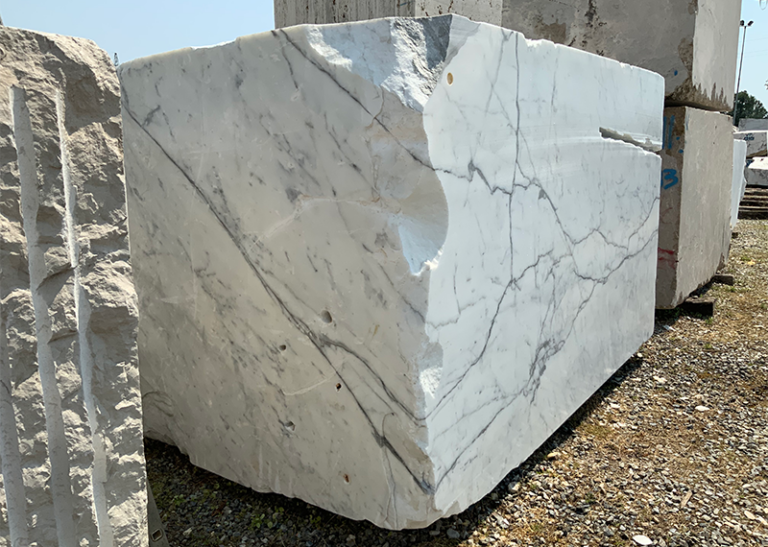Purchase agreement
▪ BLOCKS ENCODING
Each block must be identified by a unique code represented in written form on the block (marking, better illustrated in the following paragraph); The coding of a block is very often regenerated at each passage: typically the first coding is given by the original quarry, which follows its numbering; the yard (of the quarry or not) can proceed with a re-coding using a new serial number.
Finally, the customer who buys from the yard typically uses his progressive coding for each block purchased. It is good to keep track of the coding sequence and above all, it is very important to avoid any confusion at this level.
The coding is reported on the block through an operation called “marking”, illustrated in detail in the following chapter.
▪ MATERIAL
Nature of the material (marble, travertine, onyx, granite…)
▪ VARIETY
Specified typology (venatino, statuario, statuarietto…)
▪ WEIGHT
To be measured with certified and documented weighing, weight is an essential element as typically in the marble sector it represents the billing unit of measurement.
▪ DIMENSION
They are generally indicative, as in many cases the specific geometric aspect of a block cannot be represented exhaustively with only three measurements, but this approximation is commonly accepted for practical purposes. The so-called “all marble” measure is usually indicated, i.e. the maximum overall size, but in some cases, the so-called “commercial measure” is used, which takes into account a reduction possibly due, for example, to a missing corner. In this case, subjective estimation techniques are often applied (*)
(*) 3D techniques make it possible to determine the three measurements objective, provided that a measurement method is defined (all marble, commercial measurement, other…) declared between the parties.
▪ QUALITY VALUE SCORE CARD
A standardized definition of quality parameters
▪ FINISHING OPERATIONS POSSIBLY AGREE: in the negotiation phase, cutting operations can be defined for the elimination of defective portions or containerization needs: these operations involve a weight variation that must be recorded, determining the final weight after the execution of the cuts
Data Saving
- collect in a single card data, images, and videos all loaded from a mobile phone.
- possibility to add the 3D model of the block.
- ability to create matches of blocks
- simplification of sending information to customers via a simple link
Marking method
▪ QR CODE LABELS
Some ERP systems can getnerate adhesive labels with QR CODE: in this way, it will be possible to create a link to the online product sheet via the hyperlink automatically generated by taking a photograph of the QR CODE from a mobile phone. Particular attention must be paid to fixing the label to the block to prevent unwanted accidental detachments. The label should be made in such a way as not to allow it to be reattached in case of detachment, to avoid any possibility of tampering.
▪ RFID AND SIMILAR COMPONENTS
To make the traceability of the block even more certain, RFID components (or similar devices such as Bluetooth or similar) can be used stably fixed to the block (e.g. via a cemented pin). In this case, it will be impossible to detach the device from the block without damaging its functionality.
▪ PARTIALLY COLORED BLOCK FACES
Some companies use to color certain areas of a block face to make it instantly recognizable and to create a clear background for the marking area. Attention should be paid to this practice where there are aesthetic or structural defects that could be hidden just below the painting; in general, MARENGOLD encourages the use of clear but non-invasive markings to allow correct inspection of each part of the block surface at any time.
▪ RESIN
As amply explained in the chapter ECOLOGICAL TRANSITION , resin treatment is becoming increasingly popular in the block trade, making it possible to structurally resolve situations that are also very compromised due to the presence of significant fractures.
Depending on the type of casing used (semi-transparent plastic, geotechnical fabric) commonly called “mat” or shaped panels in laminated wood, important portions of the surface of the block are hidden in a more or less absolute way, making structural testing almost impossible (to understand the pre-renovation breakage situation) but above all the concealment of the faces of the block prevents its aesthetic testing; in these cases, MARENGOLD recommends the use of 3D survey technologies, which make it possible to virtually examine the pre-resining situation. Alternatively, accurate photographic and video documentation can be of great help.
In any case, the physical marking of the block must be shown on the outside of the casing used for the resin treatment.



